

Augusta Ada Byron. Ada Byron died one hundred and fifty years before the dawn of the computer revolution, but the theoretical work of this eccentric, dark-haired noblewoman would lay the foundations for the world's first computer program.
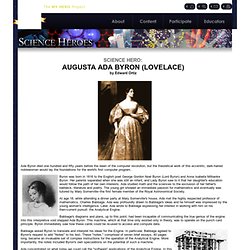
Byron was born in 1816 to the English poet George Gordon Noel Byron (Lord Byron) and Anna Isabella Milbanke Byron. Her parents separated when she was still an infant, and Lady Byron saw to it that her daughter's education would follow the path of her own interests. Ada studied math and the sciences to the exclusion of her father's bailiwick, literature and poetry. The young girl showed an immediate passion for mathematics and eventually was tutored by Mary Somerville--the first female member of the Royal Astronomical Society.
At age 18, while attending a dinner party at Mary Somerville's house, Ada met the highly respected professor of mathematics, Charles Babbage. Babbage asked Byron to translate and interpret his ideas for the Engine. Augusta Ada Byron (1815 - 1852), Countess of Lovelace. Augusta Ada Byron (1815 - 1852)Countess of Lovelace The only child of British poet Lord George Gordon Byron and Annabella Milkbanke (who was herself a proficient mathematician in an age when ladies just didn't do that sort of thing), Augusta Ada Byron showed an early flair for math and logical thought in what was to be a sadly short life.
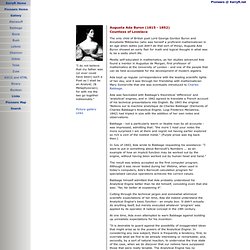
Mostly self-educated in mathematics, as her studies advanced Ada found a mentor in Augustus de Morgan, first professor of mathematics at the University of London - and one of the people that can be held accountable for the development of modern algebra. Ada kept up regular correspondence with the leading scientific lights of her day, and it was through her friendship with mathematician Mary Somerville that she was eventually introduced to Charles Babbage. Ada was fascinated with Babbage's theoretical ‘difference’ and ‘analytical’ engines, and in 1842 agreed to translate a French account of his technical presentations into English.
Lord L. Augusta Ada Byron (1815-1852) Augusta Ada Byron was born to Anna Isabella Milbanke and George Gordon Noel Byron (1788-1824), the famous poet Lord Byron, on 10 December 1815 in London, England.
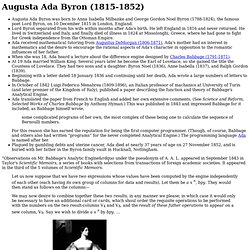
Lord Byron separated from his wife within months after Ada's birth. He left England in 1816 and never returned. He lived in Switzerland and Italy, and finally died of illness in 1824 at Missolonghi, Greece, where he had gone to fight for Greek independence from the Ottoman Empire. Ada received mathematical tutoring from Augustus DeMorgan (1806-1871). Ada's mother had an interest in mathematics and the desire to encourage the rational aspects of Ada's character in opposition to the romantic influences of her father.
“Observations on Mr. Let us now suppose that we have two expressions whose values have been computed by the engine independently of each other (each having its own group of columns for data and results). A modern reconstruction of the difference engine. The Bernoulli polynomials satisfy. Ada Lovelace: Founder of Scientific Computing. Born: London, England, December 10, 1815 Died: London, England, November 27, 1852 Ada Byron was the daughter of a brief marriage between the Romantic poet Lord Byron and Anne Isabelle Milbanke, who separated from Byron just a month after Ada was born.

Four months later, Byron left England forever. Ada Lovelace. Augusta Ada King, Countess of Lovelace (10 December 1815 – 27 November 1852), born Augusta Ada Byron and now commonly known as Ada Lovelace, was an English mathematician and writer chiefly known for her work on Charles Babbage's early mechanical general-purpose computer, the Analytical Engine.
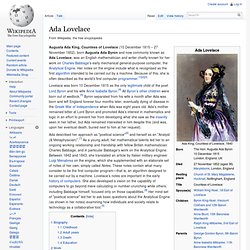
Her notes on the engine include what is recognised as the first algorithm intended to be carried out by a machine. Because of this, she is often described as the world's first computer programmer.[1][2][3] Ada described her approach as "poetical science" and herself as an "Analyst (& Metaphysician)". As a young adult, her mathematical talents led her to an ongoing working relationship and friendship with fellow British mathematician Charles Babbage, and in particular Babbage's work on the Analytical Engine. Biography[edit] Childhood[edit] Ada, aged four On 16 January 1816, Annabella, at George's behest, left for her parents' home at Kirkby Mallory taking one-month-old Ada with her. Adult years[edit] Cs-www.cs.yale.edu/homes/tap/Files/ada-bio.html. Ada Byron, Lady Lovelace (1815-1852) Contributed by Dr.
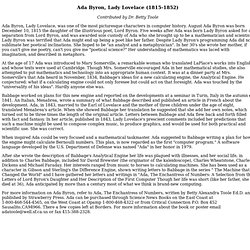
Betty Toole Ada Byron, Lady Lovelace, was one of the most picturesque characters in computer history.